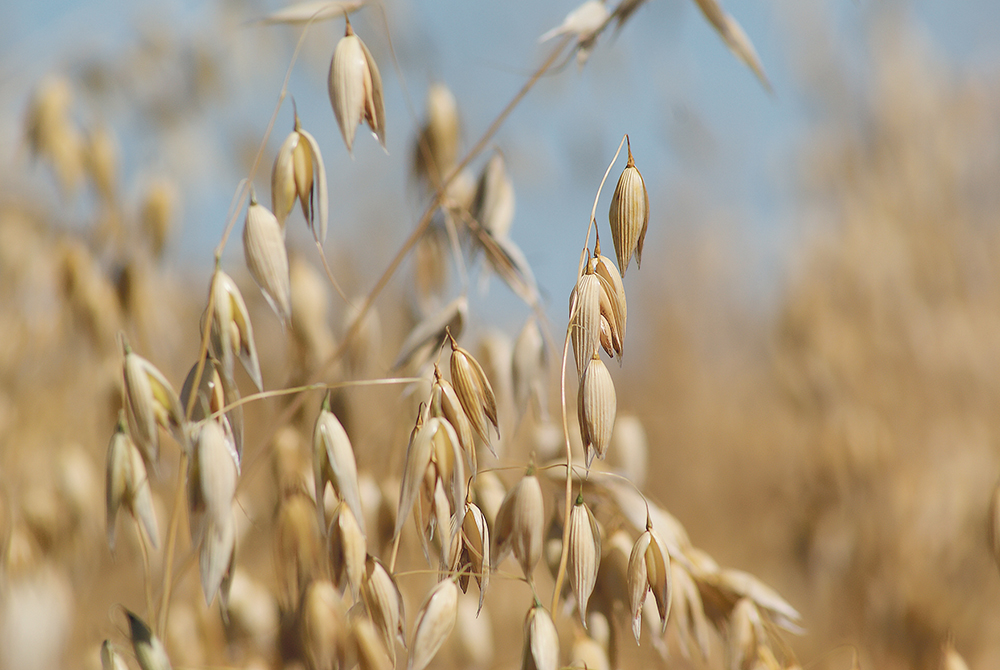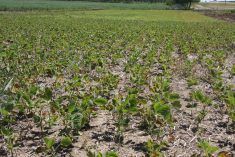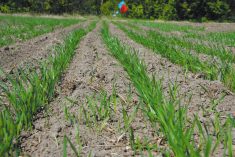Yields should be better in other oat-growing regions, but few farmers are expecting 140 bushel per acre crops this year
Harvest is probably two or three weeks away, but the oat crop doesn’t look promising in eastern Manitoba and the province’s Red River Valley.
Yields could be 30 to 40 percent below average, said Jenneth Johanson, who farms near Lac du Bonnet, Man.
Others described the situation more bluntly.
“In this area, the oats are really bad,” said Ryan McKnight, who owns and operates Linear Grain in Carman. “It will be low yielding, (low) test weight.”
Oats and most crops look horrible in the eastern half of Manitoba because the region is desperately short on moisture. From Aug. 1, 2020, to the middle of July, Winnipeg received 232 millimetres of snow and rain. That’s about 200 mm less than normal for a 12-month period.
Read Also

Critical growing season is ahead for soybeans
What the weather turns out to be in the United States is going to have a significant impact on Canadian producers’ prices
In parts of Manitoba, especially the Interlake, some farmers are harvesting their oats for green feed because the crop is so poor.
Johanson has heard of cases where crop insurers looked at oat fields in the Interlake and rated the yield potential at 20 bushels per acre, or lower. The average yield in Manitoba is usually around 100-110 bu. per acre.
Yields should be better in other oat-growing regions of Western Canada, but few farmers are expecting a 140 bu. oat crop in 2021. With poor yields in the Red River Valley and below average yields elsewhere, oat supplies could be very tight in the 2021-22 crop year.
“Nationwide production is forecast to decrease drastically from 2020-21 to 3.8 million tonnes, due to lower seeded area, along with expected lower yields and higher abandonment rate,” Agriculture Canada said in its July outlook for field crops.
“This, along with an expectation for carry-in stocks being close to a historically low level, will result in supply being 16 percent lower than the previous year.”
The department has pegged oat acres at 3.4 million, down from 3.8 million in 2020.
In northeastern Saskatchewan, some producers remain confident that they will have a decent oat crop, but a hailstorm hit the region in late July, which could cut into oat yields.
“In eastern Saskatchewan, our dry areas … guys are talking 80 to 100 bu. an acre, as opposed to the 120 to 150 that they normally see,” said Scott Shiels, grain procurement manager with Grain Millers, an oat processor in Yorkton, Sask.
Yields and overall oat production will be down in Canada, but another issue in the market is milling weight. With minimal rainfall this summer, oat crops will be lighter than normal.
Linear Grain buys grain and oilseeds from producers in Western Canada and the northern United States, but McKnight is holding off on buying oats, for now, because he’s worried about bushel weight.
“We’re pretty reluctant to put on much more new crop with farmers, in Manitoba, until we see what quality is like,” he said. “With it being so dry during the filling period… we can expect an awfully light crop.”
For Grain Millers, it needs a bushel weight of at least 40 lb.
“That’s the bottom end of our spec,” Shiels said. “We’re definitely concerned about it. Now is the time we need some rains to fill those kernels out… (But) we are definitely committed to working with what is (feasible) and mill (it).”
Complicating the issues with quality and supply, the United States oat crop could also be smaller than usual. South Dakota is a major producer of oats and in late July the U.S. Department of Agriculture rated the crop’s condition in the state at 50 percent poor to very poor.
Since North American production will definitely be down, the major buyers will likely be busy the next 12 months trying to source a supply of oats for their mills.
“Well, we’re going into the new crop (year) with basically what we could call zero carry-out,” Shiels said. “And we’ll be going on a shoestring till next year. That’s not a big secret…. Supplies are going to be tight.”
To boost stocks and prevent a repeat of this year, buyers will need to offer competitive prices next spring to encourage more production of oats in Canada and the U.S in 2022.
“I think you’re going to see aggressive pricing… for next year to get the acres back,” Shiels said. “There is strong pricing for every (crop). So, the reality is we’re competing with everything now.”
While yields will be lower than normal, oats are probably the most resilient crop in Western Canada and have tolerated the heat and drought relatively well, compared to other crops.
Hopefully, growers will remember that in 2022 and plant more oats, Shiels said.
For more content related to drought management visit The Dry Times, where you can find a collection of stories from our family of publications as well as links to external resources to support your decisions through these difficult times.



















